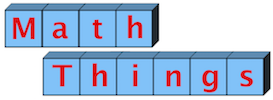"How far can you walk in a minute?"
Here’s a twofer – an activity in which students develop a sense of how long a minute is, and of distance as measured in feet or meters.
Students predict how far they think they can walk in a minute. They write their predictions down, and then walk a premeasured course until the person running the timer calls a minute. This is one of our more popular Math Night activities.
Here are some things you can do to make this go smoothly.
1. Premeasuring the course.
Borrow a 100-foot tape measure, or a longer one if someone has it. Third or fourth graders will exceed 400 feet, or 122 meters, in a minute. So you should try for a 500-foot course.
A long course with as few turns as possible is best. That way students can actually see the distance. So if you have access to the playground, a field, or a section of a parking lot, you’re in luck.
If you have a long hallway you can have students walk down one side to the end, walk across the hall, and return.
If you can use the gym, you have lines that the students can follow. Use the largest possible area.
We measure the course in 10-foot increments. If you’re using meters, 5-meter increments is good.
2. Mark the intervals
How you label the intervals, or distances, depends on the space. If students are walking down a hall, the intervals can be written on Post-Its and stuck to the wall. If in the gym or multipurpose room, Post-Its could be placed on the floor.
You can’t use Post-Its in many spaces, especially outdoors. So you need markers that allow writing, but are heavy enough so that they won’t blow away. Here’s an idea: a 100 square, which you can probably get at least 50 of, with a piece of tape or a Post-It on it. These can be placed every 10 feet or 5 meters along the course.
3. Predictions
A sheet of paper on a table or clipboard is made available to students to write their names and predictions on. You’ll need 3 columns: Student Name, Predicted distance, Actual distance.
After marking the intervals, you might want to give students a chance to get a sense of how far they can walk by having them start in groups of 5 or so and walk for 10 or 20 seconds. This will help students make reasonable estimates.
4. Timing
You’ll need an electronic timer and a student with a good loud voice to act as the official timer. It’s actually best if you don’t have more than one student walking at a time, because they tend to get competitive and then they’re not walking anymore.
You can have multiple students walking at the same time if you have multiple timers with a different student responsible for each one. Let’s say you have 3 timers. Abigail starts out when her timer, Jose, says “Go!” Ten to 20 seconds later, Benjamin starts when his timer, Teresa, says “Go!” Ten to 20 seconds after Benjamin, Mary leaves when her timer, Simon, says “Go!”
5. Results
When Jose’s timer beeps or shows 60 seconds, Jose calls out, “Amanda! Time!” And there’s no reason that Jose can’t be walking along the course carrying his timer so he’s fairly close to Amanda when he calls time. Amanda stops, notices her distance, and returns to the start to write her actual distance on the paper.
Students be able to estimate reasonably closely their actual distance between Tens. If Amanda has just passed the 340 foot interval, she might give her distance as “344 feet.”
6. Ground rules
You’ll want to talk about walking at a normal pace, which in practice means “No sprinting.” Many students will try their fastest racewalk pace. Same goes for cutting corners.
7. Extensions
If your course was marked in meters, you can calculate the number of millimeters. The total distance walked by the whole class will be in the millions of millimeters. This is a good exercise for multiplication of powers of 10, and for estimating, writing, and using large numbers.
Of course, you could also calculate the number of kilometers walked by the whole class as well.
If your course was marked in feet, you can calculate the number of inches or miles walked by the whole class. The miles calculation is a little more interesting because the number 5280 is less familiar to students. Calculator use is an option.
